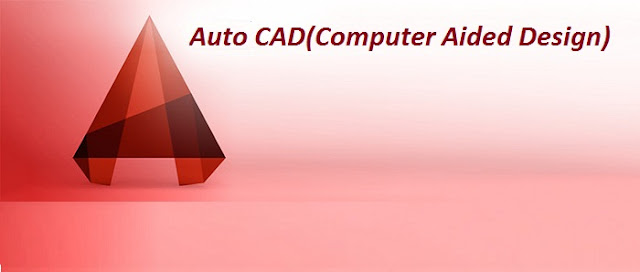AUTO CAD OVERVIEW
AutoCAD is an interactive drawing system
designed to permit a user to construct or edit a drawing on a graphics display
screen. It was introduced in the early 1980’s by “Autodesk Inc.”, California,
U.S.A.
|
There
are many reasons for using AutoCAD:
|
Business Competition
|
The most potent driving force is competition. In order to win business,
companies used CAD to produce better designs more quickly and more cheaply than
their competitors.
Productivity is much improved by a CAD program enabling you to easily draw
polygons, ellipses, multiple parallel lines and multiple parallel curves.
|
|
|
Color
and Hatch Patterns
|
The speed is increased by the use of automatic fillets and chamfers;
the computer ability to "snap" automatically to particular geometric
points and features will spread the accurate positioning of line work.
Copy, rotate and mirror facilities are also very handy when drawing symmetrical
parts.
Many hatch patterns are supplied with CAD programs. Filling areas in
various colors is a requirement in artwork and presentations.
|
Importing
Graphic File formats
|
The possibility of importing different graphic file formats and scanning
of material (photographs) into a CAD program is also an asset especially as the
image can be manipulated, retouched and animated.
|
Inserting
Existing Components
|
Using CAD products, assembly drawings can be constructed by inserting
existing component drawings onto the assembly drawing and positioning them as
required.
|
Fast
Documentation
Components
|
Clearance between different components can be measured directly from the
drawing and, if required, additional components designed using the assembly as
reference.
CAD is very suitable for repetitive and fast documentation where a
product is one in a range of sizes. Assume that you manufacture a range of
motor driven pumps operating at different pressures. Many parts will be used in
different combinations in the range and the computer database documentation is
programmed accordingly.
A computerized tender can be sent with the appropriate specification and
technical details. On receipt of an order, all of the documentation relating to
manufacture, testing, dispatching and invoicing will be available.
|
Saving
of Time
Components
|
Previously, engineers and drafters wasted almost 30% of their time
looking for drawings and other documents. Editing drawings to effect revisions
and produce updated parts lists is quick and easy using a CAD product.
|
Transfer
Facility
Components
|
|
Complex
Geometry
Components
|
In CAD, you make the change immediately and print out a new drawing in
minutes, or you can transmit it via E-mail or Internet all over the world
instantly.
On paper creating complex geometry often involves a lot of measuring and
location of reference points; In CAD it is a breeze and revisions are even
simpler.
|
Facility
to make Different Ideas
Components
|
Many CAD programs include a macro or an add-on programming language that
allow customizing it. Customizing your CAD program to suit your specific needs
and implementing your ideas can make your CAD system different from your
rivals.
|
Better
Designs
Components
|
CAD can enable companies to produce better designs that are almost
impossible to produce manually and to eliminate dubious options during the
conceptual design phase;
For example in area of complex surfaces and Finite-element analysis.
|
Rapid
Generation of Proposed Models
Components
|
Many CAD systems permit the rapid generation of models of proposed
designs as wire-frames. The computer memory stores details of all the geometric
data to define each part of the frame. From the dimensions of the components,
the computer will calculate surface areas, volumes, weights for
different materials, center of gravity, moments of inertia and radii of
gyration; it can also use the applicable value for stress and other
calculations, which are necessary part of design.
|
Transfer
of Solid Models
Models
Components
|
The solid modeling created in CAD can be transferred to a Finite
Element Analysis (FEA) program, which will then verify whether the
suggested design will be capable of supporting the expected loads.
|
Prototyping
Models
Components
|
The biggest contribution of computers to the design process is soft
prototyping - the process of creating a 3D-computer model of a design that can
be subjected to computer-based testing. Soft prototypes are almost faster and cheaper
to built than real prototypes and are often better at their main activity than
a real ones; That because model shop prototypes usually use processes and
materials very different from those ultimately used for the production version
of the product.
|
Resemble
the Real Material
Models
Components
|
|
Rendering
and Animation
Models
Components
|
The soft prototypes can resemble the final product much more closely than
any real material prototypes. Realistic images of the soft prototypes can be
used by marketing people to produce sales collateral, manuals and the whole
gamut of marketing materials. They can even be used for testing marketing to
determine whether the product is worth producing at all. Sale departments use
3D illustrations in brochures and literature for promotional applications.
Presentation programs with rendering models and animation in 3D form a
large part of selling and advertising in today competitive market.
|
Comprised
Instructions for Machines
Models
Components
|
|
Checking
Models before Manufacturing
Models
Components
|
CAD will be linked to CAM (Computer Aided Manufacture) whenever
possible. CAD/CAM systems could produce computerized instructions for
computerized machine controllers: lathes, mills, machining centers, turret punches,
welding equipment, automated assemblies, etc.
The resulting NC program can be exported back into the CAD system to
produce a simulated back plot of the tool path or imported into a solid
modeling NC program to produce a computer model for checking before
manufacture.
|
Types Of Engineering Drawing
|
1.
Mechanical
Drawings
2 .
Civil Drawings
3 .
Architectural Drawings
4.
Schematics
5.
Block Diagrams
6.
Assembly Drawings
7.
P&I diagrams etc
8.
Plant layout diagrams
9.
Wiring diagrams
10.
Hydraulic power diagrams
MECHANICAL ENGINEEGING: - Auto CAD, Catia,Proe,Solid Work,Ansys
etc
CIVIL
ENGINEERING: -
AutoCAD, Stadd, Solid Work etc
Drawing is a graphical representation
for expressing
a
view or Idea.
(1)2D (2)3D (3)Isometric (4)GIS.
|
|
Ø Well
industrial experienced faculty.
Ø Demo class
provides .
Ø Project
materials provide to the students of DIITM.
Ø Well
equipped computer Lab.
Ø Excellent
education environment.
Ø Placement
provide in good industry.
Ø Industrial
visit.
For more information visit our institute NCA NOIDA Auto Cad Training Institute




Comments
Post a Comment